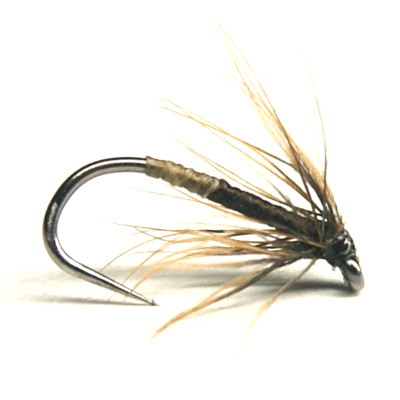
fancy a pint?
Following on from the Beech Hedge Soft Hackle post, this is another soft hackle wet fly I named from the colours of the fly pattern, not to mention the inspiration behind behind it; a glass of ale!
Typically minimalist in design and in keeping with the soft hackle/spider tradition of sparseness, I would suggest it is representative of a range of natural insects. In the way that a Black Spider is representative of a number of natural black insects found in or on the water, the Ale Spider will hopefully represent a number of brown, fawn or tan ones. As always however, it will be the trout that decide how acceptable it is!
This pattern just uses two materials in its construction, or three, if you count the the two colours of tying thread. Tan 8/0 tying thread was used for the rear 1/3 or so of the body and brown 8/0 thread was used for the rest. I employed a little trick I sometimes use on thread-bodied spider patterns, and that is to leave a longer than usual tag of thread when first catching on the thread to be used as the body, and then use the tag to form a rib over the thread body once it has been created – in the same way you would tie in and use a wire or tinsel rib, only it is a rib of the same tying thread used for the body. You may just make out the thread rib on the tan section of the pattern in the image. The thread rib just gives the body a slightly segmented appearance and may also give it a bit more strength too. I used the technique on both the tan and brown thread sections making up the body. That just leaves the hackle for the fly and I opted for a soft furnace hen hackle and of course a greenwell hen hackle could also be used instead.
Hopefully, this will prove to be a useful generic soft hackle wet fly for either use on the river or stillwater. Fished in the surface film or just below it, I hope it will be acceptable as a drowned adult insect or one that has just alighted onto the surface or alternatively, as a hatching insect such as brown or fawn coloured midge. Fished a bit deeper down, it may be taken for an ascending insect pupa, one rising through the water column to begin the hatching process.
Often, I have examined what appeared at first to be an insect of one colour only to discover that in fact, it consisted instead, of several subtle shades of one colour and that often a lighter section to the rear of the abdomen was present. The inclusion of a tan section in the pattern was an attempt to suggest this slight variance in colour.
I hope you like the Ale Spider and let me know how it works for you if you do decide to tie a few of your own. Tight lines everyone!

I like your “thread tag for the rib” trick. It should be visible enough to give the look of some segments.
LikeLiked by 2 people
Thank you, it does indeed create a segmented effect as you say. I like how it gives a subtle, natural-looking segmentation effect when using lighter coloured thread, especially when the fly is wet.
I quite often use a thread rib on a floss bodied fly too (say a on a Black Spider). What happens with that is that when a trout takes your fly, the teeth of the fish often rips and frays the floss in between the thread rib, leaving a slightly rougher looking body which I quite like. On a newly tied fly using a thread rib and floss body, if a fish takes the fly but for whatever reason promptly comes off again, the frayed floss body of the fly can help you pinpoint which fly the fish took when using more than one fly on your leader. I use two flies quite often so it can be useful to identify which pattern was taken when you are working out what fly to use.
LikeLiked by 1 person